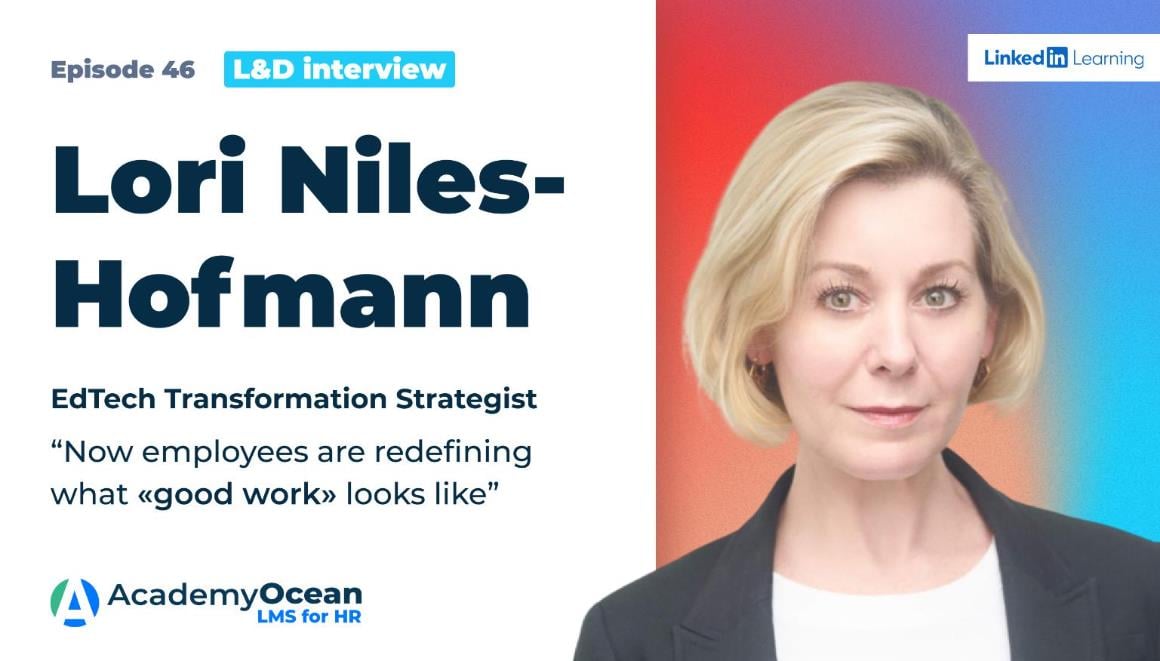Lori Niles-Hofmann: “Now employees are redefining what «good work» looks like”

Hello everyone! We continue to invite leading L&D specialists!
And today Lori Niles-Hofmann shares her most valuable experience and knowledge with us.
🤩 Let's get to know her better!

Lori Niles-Hofmann is a senior learning strategist with 25 years of L&D experience across many industries, including international banking, management consulting, and marketing.
Her specialization is large-scale digital learning transformations. Lori is passionate about helping companies navigate through the ambiguity of change and act as a trusted adviser to Fortune 500 CLOs around the world. After leading and completing numerous EdTech implementations, Lori has developed the data-based methodologies and frameworks that will empower L&D teams to move from business support functions to a strategic business driver.
AO: Hello Lori! How did you come to the L&D sphere? And what do you love most about your job?
Lori: Well, when I graduated from university, lots of people my age were going to places like Japan and Korea to teach English. I decided I wanted to do the same but also reconnect with my family, so I moved to Northern Poland and taught at a high school and university. It was amazing, but I made absolutely no money.
When I came home I had to find a job quickly, and so I took the night shift at a banking call center. Within a few months, I was creating job aids and cheat sheets. They saw my potential and moved me to their national learning center. The rest is history…
AO: Great, that is, your natural abilities have shown up :)
How do you think the war in Ukraine and the subsequent humanitarian crisis around the world affected the sphere? How does this impact L&D professionals?
Lori: This is difficult to answer from sitting at a desk in Canada. But I know from my family in Poland and my global network it has strengthened the argument for strong digital connections and ecosystems where validated information can be developed and deployed rapidly where needed.
For L&D professionals, I think it puts a direct spotlight on solving real problems, rather than some softer ones, like leadership or communication skills that we try to teach in the workplace.
For example, McGill University (a Canadian institution) created virtual training in a matter of weeks to teach anybody life-saving procedures.
AO: Will such a phenomenon as a war for talents still be relevant (in today's realities)?
Lori: Absolutely.
Because we are coming out of a period of massive panic (COVID-19) employees are examining their relationship to work and life; redefining what “good work” looks like. There is less incentive to stay in a role which does not align with personal values.
Likewise, the half-life of skills is shrinking, so it really is a employee market for those who stay current. Employers are also struggling to find niche skills that are so desperately needed for innovation.
AO: Usually, in times of crisis, one of the first costs that companies cut is the cost of L&D. How do deal with this, and what could be the arguments against such cuts?
Lori: We have not actually seen a decline in budgets for L&D but rather an increase.
Companies who take this shortsighted approach are already challenged to have a workforce fit for now and the future.
AO: Please, name 3 to 5 professional qualities that L&D specialists should develop in themselves during a crisis.
Lori:
Strategic thinking (stop being tactical and building course after course)
Data Analytics (to make rational and impactful decisions)
Empathy (to lead with compassion)
AO: Let's digress from difficult topics a little :)
I heard that you are called the queen of analogies. Tell me more, how did it happen? It is very interesting! And maybe you have in stock some vivid examples of an analogy on the topic of learning 😀
Lori: I’m not sure if I am the queen of analogies, but I do really like them!
One that I have been using is to think about skills as tomatoes 🍅. Talent Management is like a purchaser. They will know how many tomatoes there are in the market, whether they had a good growing year, if they need to be imported, etc. L&D will know how long it takes to grow a tomato (skill) from a seed, what conditions are required, and how much it still cost.
When you are looking at a learning intervention, you need to think about that tomato. Is it easier to find it in the market, or should you invest in building it. For some skills, there is a distinct shortage, and you need to grow it. For others, it would be better to bring in new people with specific talents.
AO: Cool, thanks!
I know that you and your team have developed a series of processes called The Learning Triage. Could you tell us more about the concept, and what is it for?
Lori: The Learning Triage is basically an in-take process just like you would see in an Emergency Room. If you go to an ER, you are not seen in the order you appear. It is according to urgency and the resources you have available. If you present with chest pains, you will see a doctor faster than someone with a fracture.
In L&D, they often rely on an annual plan. This makes it difficult when an “emergency” appears.
The Learning Triage is a way to assess requests and ensure those with the biggest impact to the business are actioned first.
AO: Thanks Lori for interesting answers!
I'm sure that our readers willreally appreciate it as well!
🖐 Bye!

